Ammania and its types
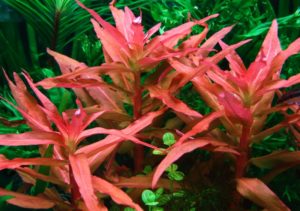 Tropical grass ammonia ... How much is said by these words! These are thickets of a large-leaved plant of reddish-yellow color in subtropical latitudes, with which rice growers (Senegal) unsuccessfully fight. And the original plant branches for landscape design closed and open reservoirs (ammania gracilis or elegant ammania). And an original, selectively bred pretty plant, so skillfully decorating small size aquariums. In the third case, this is ammania bonsai.
Tropical grass ammonia ... How much is said by these words! These are thickets of a large-leaved plant of reddish-yellow color in subtropical latitudes, with which rice growers (Senegal) unsuccessfully fight. And the original plant branches for landscape design closed and open reservoirs (ammania gracilis or elegant ammania). And an original, selectively bred pretty plant, so skillfully decorating small size aquariums. In the third case, this is ammania bonsai.
What is his charm?
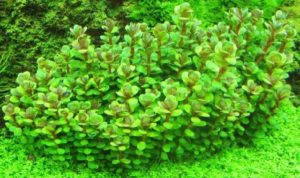
Those who had to see small aquariums decorated with original micro-trees were lucky. The sight is original and pleasant. Low thick columns up to 12-15 cm, covered with dense round leaves, bright and as if with a wax film. They are fragile and sensitive, tender and defenseless. Very touching and lovely.
Ammania sp. "Bonsai" can occupy whole areas of soil, creating natural glades of graceful greenery.
Very decorative and Senegalese Ammania. In addition, the front side of its sheet, depending on the lighting, can change its color (from green to red).
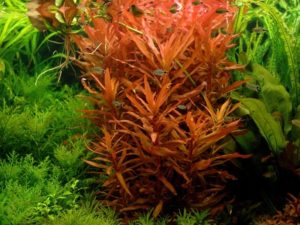
Ammania Senegalese
What are the necessary living conditions?
The plant micro species requires approximately the same conditions for growth as Senegalese ammania, as well as elegant ammania. Water should be:
- temperatures from 22 to 27 about;
- neutral acidity (indicators within 6-7);
- with stiffness indices from 2 to 12.
At the same time, aeration and filtration are mandatory. In addition, a quarter of the water in the aquarium must be changed to fresh at least once a week.
 For successful growth, the plant will like high-quality top dressing with special fertilizers, better than a complex composition.
For successful growth, the plant will like high-quality top dressing with special fertilizers, better than a complex composition.
Ammania grows better on sandy ground. Even more effective if you add river sludge to it. This will help to strengthen the roots more firmly and be more stable in case of the actions of fish who prefer to dig soil at the bottom.
Another prerequisite. It is a bright light for 10 or 12 hours. It is in this case, for example, elegant ammonia or multiflora ammonia will acquire the most effective color and will keep it.
![]()
Ammania multiflora
A very capricious plant is Ammania Sulawesi. The efforts of a beginner aquarist are unlikely to be enough to grow him. You need knowledge and strict adherence to instructions. Required:
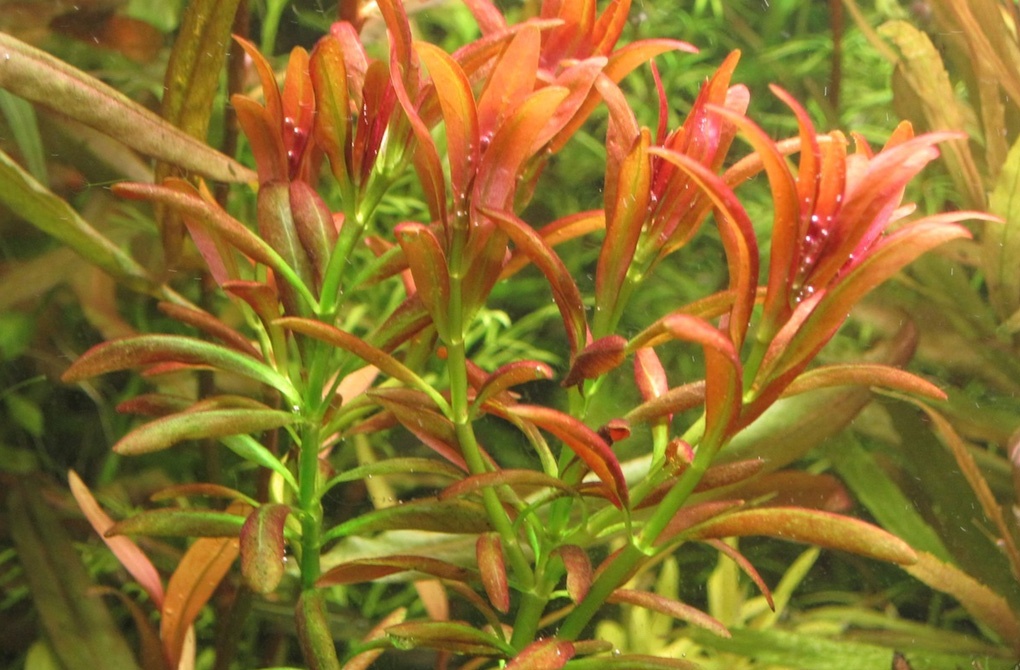
What are the ways of reproduction?
Ammania bonsai is able to reproduce in the following way: having split off a few cm of the trunk along with the apex, this process is fixed in sandy soil and creates maximum peace for it. It is better to create an artificial temporary fence in an acceptable way so that the plant is not exposed to aggressive fish.
Ammania Senegalese propagates with the help of cuttings, separated from the main trunk. It is better to take young and fresh processes. They will grow longer, but will become stronger. Cases of its reproduction using seeds are also described. But for aquarium living this is hardly possible.
Elegant Ammania requires planting shoots like a ladder. Each stalk should be at least 5-7 cm behind the adjacent one. This is necessary to ensure uniform illumination of each leaf.
Using different kinds Ammania in one water composition, you can create an original and unique landscape. It will be cozy for your beloved fish, and the owner - it is pleasant and calm from the fact that beauty reigns around.
Locals of the tropics consider this marsh grass a weed and do not pay any attention to it. However, a huge number of aquarists and professional aqua designers for decorating artificial underwater landscapes prefer it - ammania.
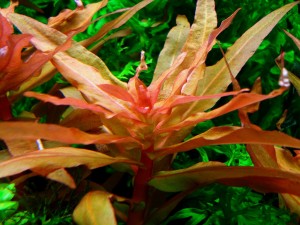 A herbaceous plant of the genus Ammania is widely distributed on almost all continents of the Earth. These species, which modern botany numbers about 25, grow in the tropical and subtropical latitudes of Asia, Africa, both Americas, and even in Europe.
A herbaceous plant of the genus Ammania is widely distributed on almost all continents of the Earth. These species, which modern botany numbers about 25, grow in the tropical and subtropical latitudes of Asia, Africa, both Americas, and even in Europe.
Species of tropical grass densely populated the banks of rivers and lakes, they are present mainly in wetlands and rice fields.
Aquatic vegetation is well adapted for living in humid places, loves warmth and bright sunlight.
By the way, in the areas of developed rice growing, this plant is considered a malicious weed, to which the peasants have long declared a merciless war.
Ammania (or ammania, according to the scientific name) was described and classified a very long time ago - at the beginning of the 18th century. The name was given to the plant by the English scientist W. Hauston in honor of the German botanist from Leipzig P. Ammann.
A little later, the outstanding Swedish naturalist and classifier Carl Linnaeus fixed this name, and subsequently the Latin name remained: Ammannia Linnaeus, which means "Linnaeus's Ammania".
According to the scientific botanical classification, the considered plant genus belongs to the family of dicotyledonous dicotyledon class. In the special literature and aquarium use both names - with one or two letters "n".
General structure and characteristic features of appearance
 Despite the fact that some types of ammania appear to be significantly different from each other, we can distinguish common symptoms for all species and subspecies.
Despite the fact that some types of ammania appear to be significantly different from each other, we can distinguish common symptoms for all species and subspecies.
The stem of the vegetation is relatively thick and strong, they move away from it in different directions large leaves. There are three main forms of this herb:
- with wide reddish leaves;
- with narrow reddish-brown leaves;
- with narrow green leaves.
In the first two forms, the leaves have wavy edges.
The height of vegetation in natural conditions can reach 70–80 cm.
Not all types of ammonia are cultivated in aquariums. This is due to both the difficulties in maintaining certain species and the low decorative qualities of individual members of the genus.
However, there are several varieties that are often found in artificial aquasystems.
Ammania Gracilis
 Its Latin name is Ammannia gracilis, which in translation into Russian means "elegant ammania." Interesting and beautiful plant originally from East Africa has long been used to create colorful aquarium landscapes.
Its Latin name is Ammannia gracilis, which in translation into Russian means "elegant ammania." Interesting and beautiful plant originally from East Africa has long been used to create colorful aquarium landscapes.
It is very popular due to the leaves, which change their shape depending on the place of their growth.
For example, on one thick stem, broad, even or slightly wavy olive-colored leaves (above the surface of the water) and narrow lanceolate leaves in the underwater part can grow.
The color of the leaves may vary depending on the nature and intensity - from olive to pink.
The stem is thick, up to 1.2 cm in cross section, which allows the plant to reach up to 60 cm in aquariums.
The substrate is sand or fine gravel. The soil must be rich in iron and other micronutrients. The color of leaves directly depends on this.
However, the saturated violet-olive color of the plant also depends on other factors - light exposure and the presence of CO2 dissolved in water.
The plant needs strong illumination - at least 0.5 W / liter of aquarium water. At the same time, the duration of daylight hours should be 11-12 hours. If the leaves begin to blacken and gradually fall off, then the lighting is poor. In this case, decorative grass degrades.
The optimum water temperature for growing this ammania in artificial conditions - from +23 to +28 degrees.
Propagated by Ammannia gracilis cuttings. To do this, it is enough to carefully separate the stalk from the trunk and you can immediately plant it in nutrient soil.
Ammania Senegalese
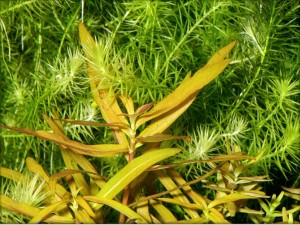 This variety (Ammannia senegalensis) is suitable for decorating both large and small aquariums, but it is more finicky and requires constant care. She does not tolerate transplantations, degrades when spoiled by the inhabitants of the aquarium.
This variety (Ammannia senegalensis) is suitable for decorating both large and small aquariums, but it is more finicky and requires constant care. She does not tolerate transplantations, degrades when spoiled by the inhabitants of the aquarium.
In your own way general structure similar to the previous view, grows up to 40 cm in height. Leaflets elongated, small, with a wavy edge. Their color on the front can vary from green to dark red. The color of the back of the leaves is purple.
Ammannia senegalensis also needs bright lighting - at least 0.7 W / l with a daylight duration of about 9-10 hours.
Ornamental grass develops well when the sandy soil is saturated with micronutrients and a small amount of carbon dioxide is introduced into the water.
The optimal parameters of the aquatic environment:
- temperature from +23 to +30 degrees Celsius;
- pH balance of 6–7 units;
- water ranging from 3 to 13 degrees.
Senegalese ammania is usually planted using cuttings, but propagation by seeds is possible.
Ammania multiflora
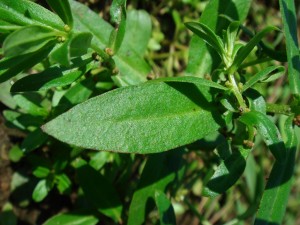 Pretty tender plant, which only experienced aquarists can successfully maintain. Ammania multiflora (Latin name) in the domestic aquarium has appeared relatively recently. Suitable for growing in aquariums with a capacity of 100 liters or more.
Pretty tender plant, which only experienced aquarists can successfully maintain. Ammania multiflora (Latin name) in the domestic aquarium has appeared relatively recently. Suitable for growing in aquariums with a capacity of 100 liters or more.
The appearance of this herb also has high decorative qualities. On a straight, rigid stem, oblong leaves of bright green color grow in different directions. In bright light, red veins that make up the original pattern can be seen on them.
This ammonia does not tolerate severe blackout at all; in such conditions, it begins to degrade rapidly. That is why the required light intensity should be around 0.6 W / L at 10-hour daylight.
Multiflora needs soft water (dH \u003d 3–8 °), and this is a prerequisite for its content. The remaining parameters of the aquatic environment are common for this genus of plants: the temperature is from +22 ° C to +30 ° C, and the acid-base balance is close to neutral.
Sand is usually used as soil, less often fine gravel. Mineral nutrition soil is only welcome.
At optimal conditions content, you can observe the appearance of small purple-pink flowers. During flowering, the vegetation looks very impressive.
Ammania Bonsai
 In vivo, this species does not exist. Ammania Bonsai was artificially bred for nano-aquariums. The Latin name of the plant is Ammania sp. "Bonsai", which indicates the result of the work of breeders.
In vivo, this species does not exist. Ammania Bonsai was artificially bred for nano-aquariums. The Latin name of the plant is Ammania sp. "Bonsai", which indicates the result of the work of breeders.
Maximum height the stem is 15 cm, small bright green leaves grow densely on it, the size of which is no more than 1 cm. There are so many leaves that the stem is almost invisible, and several sprouts standing next to it decorative grass form a kind of bush.
- The required water parameters are the same as for ammania multiflora.
- The soil should also be sandy, but for the stable development of vegetation, a little river silt should be added to it.
The development of the decorative thicket is positively affected by weekly water changes - ¼ part of the total volume.
Ammania of Senegalese is most often found in nature on the expanses of the African continent: in Abyssinia, Lower Egypt, from Senegal to South Africa and in a number of territories of distant East Africa. As for the living conditions of this aquatic beauty, they can be absolutely anything - the Senegalese wet ammania or equally suitable water environment, flood plots, rice fields and even salty soils. This amazing plant will be a great decoration for almost any aquarium. Best of all, Senegalese ammonia looks in the middle ground.
Getting to know the plant
The height of the surface stalks of Senegalese Ammania often reaches forty centimeters. The stems of this aquatic inhabitant are fleshy and naked, and root system not particularly well developed. The length of leaf blades can be up to six centimeters, and their width is about one and a half centimeters. Due to the fact that the planes of the leaves are rather convex, their edges are slightly curled down. And the shape of the leaflets can be either lanceolate or elliptical.Senegalese ammania inflorescences are not very dense and are formed by one or several flowers, up to a maximum of five. Purple flowers are formed in nodules of surface shoots. All of them are endowed with funny sitting stigmas, and they have four petals and stamens.
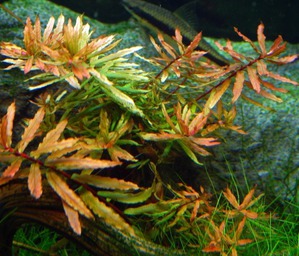
A distinctive feature of Senegalese Ammania is that it is characterized by both horizontal and vertical growth. That is, to choose this plant for the water level in the aquarium is not particularly difficult. And as the water level rises, Senegalese ammonia begins to slowly grow in length.
How to grow
Senegalese ammonia is very whimsical, capricious and very photophilous in its habitat. Shady places for its development are categorically not suitable. It is allowed to grow this beauty in small aquariums. By the way, to grow it with all its whimsicality will not be difficult - Senegalese ammonia can grow well both in open aquariums and when completely submerged in water. If this beauty is created very favorable conditions, then she will develop with incredible speed.Senegalese ammonia is recommended to be grown in a soil rich in all kinds of nutrients (sand and gravel are suitable), in fairly soft water, and also under very intense lighting, depending on which the color of the leaves of this beauty changes. In one light they will be light yellow with a slight pinkish tint, and in another they will be pink. And sometimes the leaves are painted in pale red or pale green. The daylight hours of Ammania Senegalese should be between eight and ten hours. Most optimal temperature condition for its full development is in the range from 22 to 28 degrees. And here decorative look this aquatic inhabitant will gain only if you grow a whole group of underwater specimens.
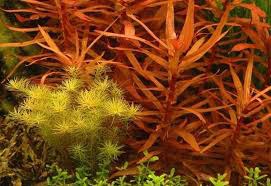
Various nutrients should be added to the soil periodically in relatively small quantities, since Senegalese ammonia receives the main food mainly from the soil.
If suddenly this magnificent plant began to grow poorly, it is advisable to try to transplant it to another place, after adding a small amount of clay under its roots. Peat is also suitable instead of clay.
The most effective will be the reproduction of Senegalese ammania using lateral shoots. In addition to cuttings, perhaps seed propagation this aquatic creature. As a rule, specimens growing on the surface are propagated by this method. Periodically, the distribution of this aquatic beauty should be limited.
Sometimes Senegalese ammania is compared with elegant ammania. This is due to the fact that distinctive features they really have quite a few, and apparently they are very similar. Moreover, the methods of their reproduction and conditions of detention are also almost identical. However, despite this, these are still different plants.
Varieties of plant ammonia are of interest both to aquarists who breed fish in "classic" tanks, and for those who have a "tropical" aquarium. Some types of ammonia are also suitable for small nano-aquariums. Some of these aquatic plants are problem-free to care for, while others are recommended to be bred exclusively by aquarists with extensive experience.
What does Ammania look like?
The genus Ammania from the family Derbennikovye (Lythraceae) has about 25-30 species of aquatic plants.
The most famous of the types:
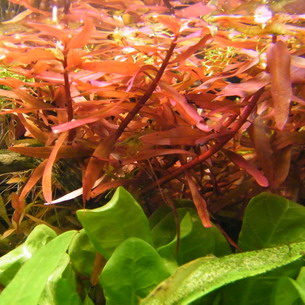
Ammania Gracilis (Ammannia gracilis).
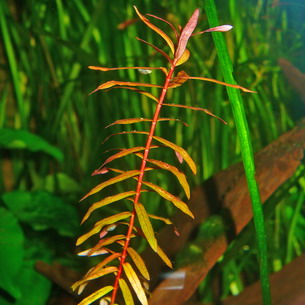

Senegalese (Ammania senegalensis).
Tropical perennial native to West Africa, where it grows in water and along the banks of swamps, rivers and.

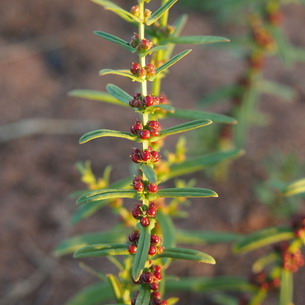
What does ammania, so beloved by aquarists, look like? On a straight fleshy stalk, narrow and wavy sessile leaves are located. Their color depends on the light intensity and can vary from pale green to bronze and red. The height of Ammania can reach 60 cm.
Pay attention to the photo - the flowers of ammania are nondescript, pale lilac, growing from the axils of the leaves:
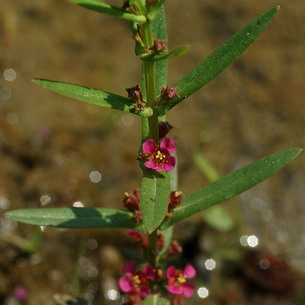
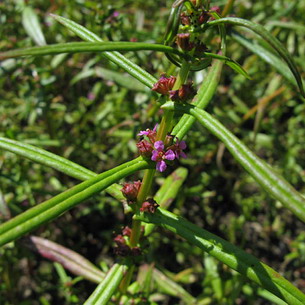
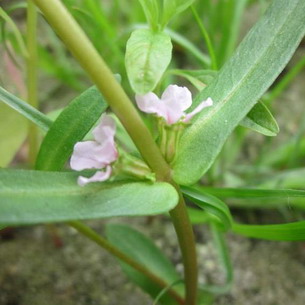
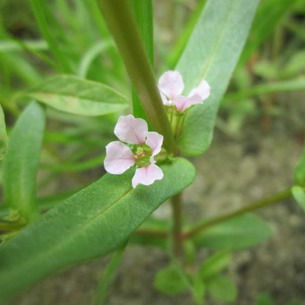
Ammannia prefers a lot of light. It can grow quickly under favorable conditions in a small shallow pond with a loose sandy substrate. If the lighting is not strong enough, then the plant loses its lower leaves, development slows down, and the remaining leaves will be pale and painful. Iron and nutrient supplements are recommended. The ideal state of water is slightly acidic and moderately soft. The temperature should be in the range of 22-28 ° C, at least 15 ° C.
In late spring, when the weather is warm, ammonia is transferred to open air and transplanted into a reservoir or just put a container with a plant in it so that 5 to 50 cm of water remains above the ammonia. A swampy shore is also suitable for planting. The place should be well lit. At the beginning of autumn, they are transferred to a house and put a container with a plant in the aquarium.
Aquarium plant ammonia is easily propagated by cuttings placed in a substrate. Cuttings are obtained by cutting the side shoots from the main trunk. The old base of the stem will give new shoots and leaves if you cut off its top, so if you want more bushiness, it is recommended to cut off the stem in the middle when its top reaches the water surface.
Ammania graceful gracilis (ammannia gracilis) for a tropical aquarium
Ammania graceful (ammannia gracilis) grows along riverbanks and in flooded areas in West Africa. It is one of the most popular aquarium plants.
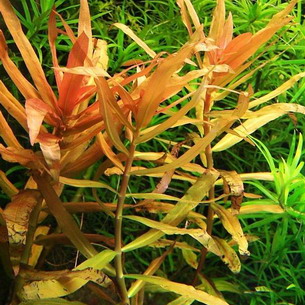

Graceful Ammania has an erect, fleshy and bare stalk, reaching a length of 60 cm. The leaves are sessile, whole-extreme, cruciform-opposite. Surface leaf plates are painted in olive-green color and have a shape from linear to obovate. They grow in length from 2 to 6 cm, in width -1.0-1.8 cm. Underwater leaves are lanceolate, 7 to 12 cm long, 0.7-1.8 cm wide. The front side of the leaf is painted from olive green to brownish red, the back is purple. The inflorescence consists of 3-7 pale lilac flowers. The fruit is in the form of a two-nested spherical capsule with rounded seeds.
Suitable for a tropical aquarium with a volume of at least 100 liters.
Pay attention to the photo - ammania gracilis is planted one stalk with a ladder (5-7 pieces), separately from each other in the center of the aquarium:
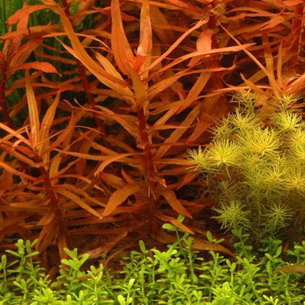
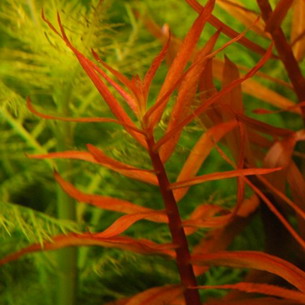
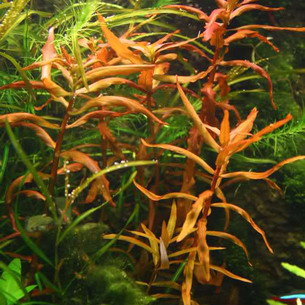
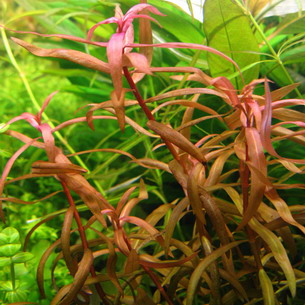
Water parameters for the optimal growth of elegant ammania: hardness 2-12 °, pH 6.5-7.5, temperature 23-28 ° C. Lighting in the aquarium should be bright. The power of LB type fluorescent lamps should be 0.4-0.5 W per 1 liter of volume, and additional illumination with incandescent lamps with a power of 25-40 W located above the plant is also useful. Daylight hours should last about 12 hours. With a lack of light, the leaves on the lower nodes begin to blacken.
Sand or gravel rich in soil is suitable. nutrients and iron. Depending on the light intensity and the presence of nutrients in the soil, the color of the leaves can vary from pale green to bronze red. Graceful Ammania propagates by cuttings of lateral shoots and seeds.
Ammania bonsai (ammania sp bonsai) for nano-aquariums
Ammania Bonsai - a product of breeding work, this plant was specially developed for small nano-aquariums. In general, this plant is very similar to Caroline bacopa (Basora caroliniana), but in contrast to it grows more slowly and has a smaller size.
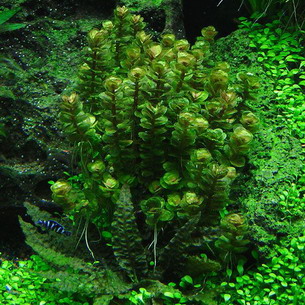
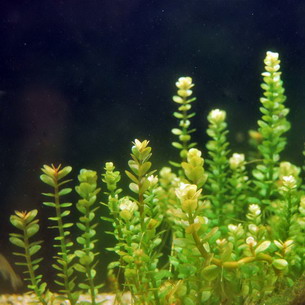
Ammania sp. "Bonsai" (Ammania Bonsai) has a straight and rather strong, fleshy stem. In general, when you look at the bush of a plant, its thick stem looks somehow unnatural, however, this does not in any way spoil its external attractiveness. On the stem in large numbers are oval-shaped leaves, the size of which is about 1 cm. The maximum height of the bush is 15 cm and its width is up to 1.5 cm.
Ammania bonsai must be planted in the aquarium in the foreground. Growing, the plant forms very colorful decorative thickets, which for a long time retain their original appearance due to the low growth rate.
Water parameters should have the following characteristics: temperature 22–28 ° С, hardness dH 2–12 °, acidity pH 6.5–7.5. Filtration and weekly replacement of ¼ of the aquarium water with fresh water is required. Feeding CO2 is desirable, which has a beneficial effect on plant growth. Periodic top dressing with complex mineral fertilizers is necessary.
Particular requirements are placed on lighting, which should be quite bright, with an intensity of 0.5 W / l. Only under bright light in ammania bonsai leaves are formed in the upper part of the bush with a reddish color. With a lack of light, the leaves in the lower part of the bush become faded and gradually die off. In this case, the plant is extended in length and takes on an unpresentable appearance.
Ammania is growing slowly, so brushing is rarely done. During the haircut, 2/3 of the plant is usually cut, and the cut off top is planted in a new place.
It is advisable to use river sand or fine gravel as soil. The soil should be medium silted. The plant consumes the bulk of its nutrients from water.
Swamp Ammania Senegalese (senengalenzis)
Ammania Senegalese grows from Senegal to South Africa, in East Africa to Abyssinia and Lower Egypt. It is quite rare in amateur aquariums, because it is very capricious, requires careful care and care.
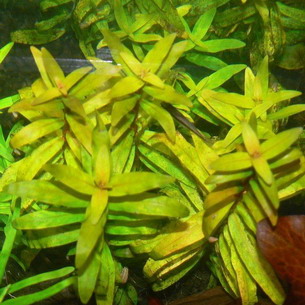

Ammania Senegalese (Ammania Senengalenzis) - a marsh plant with an erect, fleshy and bare stalk, up to 60 cm long. Leaves are sessile, whole-marginal, cruciform-opposite. Surface leaf blades from linear to obovate, 2-6 cm long and 1.0-1.8 cm wide, olive green. The surface stem is up to 40 cm high. The underwater leaf blades are lanceolate, 7 to 12 cm long and 0.7 to 1.8 cm wide. The color of the front side of the leaf is olive green to brownish red, the back is deep purple. Inflorescence - dichasia with short pedicels with 3 to 7 flowers.
This plant is suitable for growing in both small and large aquariums.
As you can see in the photo, Senegalese Ammania is planted in the background or in the middle planes:

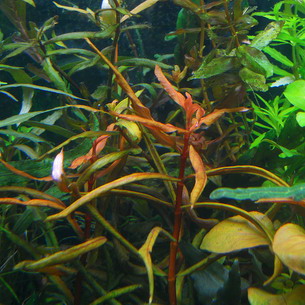

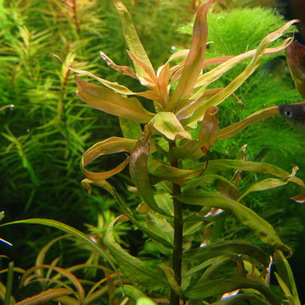
It is used by experienced decorators to create picturesque underwater lawns. Growing fast.
The water parameters are optimal for the content of Senegalese ammonia: hardness 2–13 °, pH 6.0–7.0, temperature 22–30 ° C (leaf discharge is possible at low temperatures). Lighting in the aquarium should be bright. The power of LB fluorescent lamps should be 0.7-0.8 W per 1 liter of volume. Duration of daylight hours is at least 8-10 hours.
Sand or gravel rich in nutrients is suitable as a soil for Senegalese Ammania. It reacts positively to the application of liquid fertilizers and the additional saturation of water with carbon dioxide.
Senegalese Ammania is propagated by cuttings of lateral shoots and seeds.
Ammania Senegalese can also be grown in paludariums, aquaterrariums and wet greenhouses. It requires very careful handling, does not like frequent transplants and anxiety from large amphibians.
Decorative Ammania Sulawesi

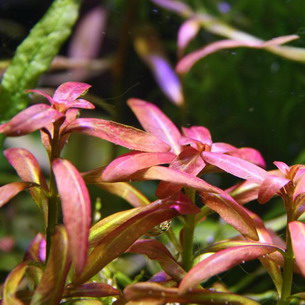
Ammania sp. Sulawesi - a very beautiful variety, which fell into the collection of aquarists from the island of Sulawesi. Widespread due to its high decorative qualities and original appearance. The plant is characterized by slow growth and exacting conditions. However, these difficulties are fully paid off by the incredible beauty and brilliance of this instance.
Under favorable conditions, the leaves of Ammania Sulawesi acquire an unusual red-violet hue, which allows the plant to contrast favorably with other inhabitants of the underwater environment.
Ammania sp Sulawesi is best planted in small groups (5-7 stems), so this specimen stands out against the background of green plants and attracts attention.
Ammania multiflora for experienced aquarists
Ammania multiflora - a plant that relatively recently appeared on the domestic market. The plant is pampered, requiring constant care, therefore, for keeping it in an aquarium, it can be recommended only to experienced aquarists.
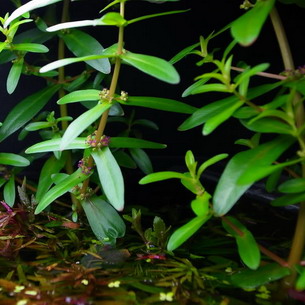

Ammania multiflora has a pretty decorative look. The leaves of the plant are wider in comparison with other types of ammonia. The leaves are painted a bright green color, however, they change their color in bright light to reddish. The stalk is hard, erect.
The leaves are wider in comparison with other representatives of the genus Ammanii. The color of the leaves is bright green. If there is intense lighting in the aquarium, then you can see red-pink overflows. The shape of the leaves is oval. The barrel of Ammania multiflora is very hard. The growth rate is average. In aquarium conditions, the size of the bush reaches 30 cm.
Given the relatively large size of the bush, it is desirable to plant it in the central part of the aquarium. The aquarium should be quite spacious, with a volume of 100 liters or more. Ammania will look especially beautiful in a Dutch-type aquarium, where the plant will certainly attract attention with its bright color, clearly distinguishing itself from the general background.
Water parameters must satisfy following requirements: temperature 22-30 ° C, hardness dH 2-8 °, acidity pH 6.5-8.0. It is especially necessary to pay attention to the hardness of the water, the plant is able to grow only in soft water, in hard water it begins to wither and soon dies. The plant reacts very positively to the application of iron-containing fertilizers due to which the color of the leaves becomes yellowish-pink.
Lighting should be bright, with an intensity of 0.5 W / l. The daylight hours are 10-12 hours per day. The plant does not tolerate dimming at all, this must be taken into account when planting ammonia in the aquarium. A sign that light is not enough for the plant is the dropping of leaves. As soon as you notice this, you need to immediately increase the intensity of lighting, otherwise the plant will die.


